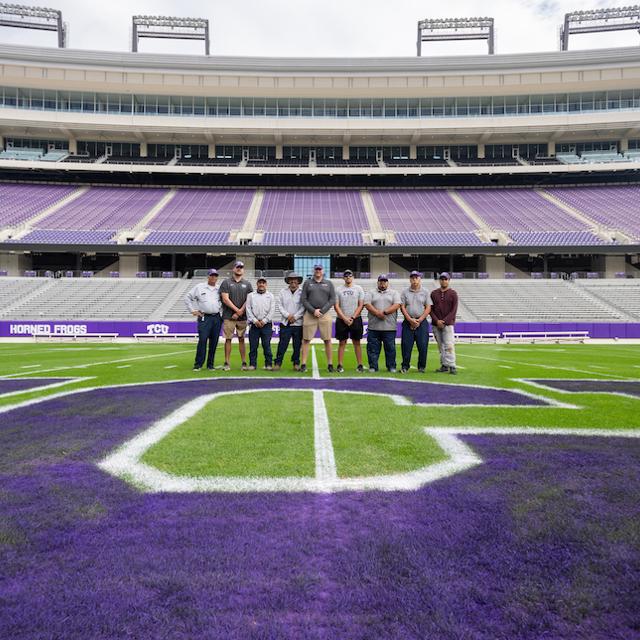Natural turf – like the athletes who play on it – has to be tough to withstand daily workouts. It’s also delicate, needing a “just right” amount of drainage, sunlight, mowing, fertilizer and, of course, water. So it’s a bit of an art and science to keep a field lush and, most importantly, safe.
TCU’s W.A. “Monty and Tex” Moncrief Field at Amon G. Carter Stadium as well as the Garvey-Rosenthal soccer field have natural grass. In fact, the football field is one of only three Big 12 teams that use natural turf. (The others, if you’re wondering, are Oklahoma University and Iowa State.)
With football season underway, Sports Field Manager Andrew Siegel and team are busy keeping the field game day-ready, and, like anything, it’s a process.
Typically, they let the surface “heal” during the summer months and before football camp begins. Once practice and games are underway, their challenge is to get the field back into plush and consistent condition each week.
Challenges they face include rain and the stadium’s architecture. The former can cause disease that spreads fast and needs to be quickly contained. Because the east side of the field gets a lot of shade, it’s difficult to keep the Bermuda grass, which likes hot conditions, established.
“It’s tricky,” explained Erik Trevino, director of landscape and grounds for TCU. “But Andrew and his team keep the field looking great.”
Some of the practices they follow throughout the season include mowing the grass to less than an inch multiple times a week, aerating and top dressing with sand. Preparations for the next game begin immediately upon conclusion of that week’s game. This includes mowing, fertilizing and other cultural practices. In the winter months, they use a winter grass seed variety and then start the process all over again in the spring as they the transition to Bermuda.
“We use a hybrid Bermuda sod on top of 12 inches of sand,” Siegel said. “We believe it results in far fewer injuries.”
The soil, he explained, moves with the body vs. synthetic surfaces that are less forgiving and can also cause turf burn.
The turf team obviously has a winning formula as the Sports Turf Managers Association (SFMA) awarded Siegel and TCU with a pair of Field of the Year awards in 2021 for both the football and soccer field surfaces.
One other art of maintaining the field is literally art: the stenciling and painting of the TCU logo in the end zones.
“They get it just right and before every football game,” said Trevino. “Then they re-do it for games like the Armed Forces Bowl. I’m always so impressed with the artistry that goes into it.”
